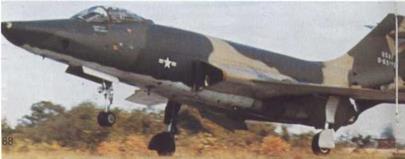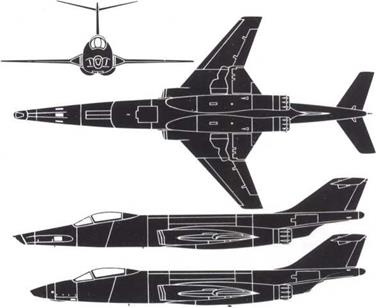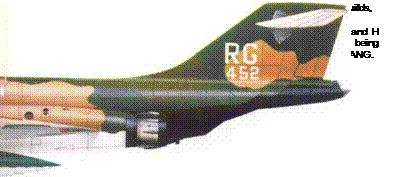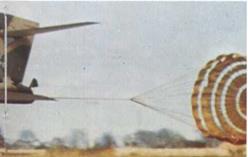McDonnell Douglas F-101 Voodoo
F-101 A, В and C and RF-101A to H
Origin: McDonnell Aircraft Co (division of McDonnell Douglas Corp), USA. Type: (A, C) day fighter-bomber: (B) all-weather interceptor: (RF) all – weather reconnaissance.
Engines: Two Pratt & Whitney J57 two-shaft turbojets with afterburner: (F-101 B) 14.9901b (6800kg) J57-53 or -55 (others) 14,8801b (6750kg) J57-13.
Dimensions: Span 39ft 8in (12’09m); length 67ft 4|in (20-55m): (RF) 69ft 3in: height 18ft (5’49m).
Weights: Empty (typical of all) 28,000lb (12,700kg): maximum loaded (B) 46,700lb (21,180kg): (all versions, overload 51,0001b, 23,133kg). Performance: Maximum speed (B) 1,220mph (1963km/h, Mach 1 -85): .(others, typical) 1,1 OOmph: initial climb (B) 17,000ft (51 80m)/min: service ceiling 52,000ft (1 5,850m): range on internal fuel (B) 1,550 miles (2500km): (others) 1,700 miles (2736km).
Armament: (B) three Falcon (usually AIM-4D) air-to-air missiles semi – submerged in underside, sometimes supplemented by two AIR-2A Genie nuclear rockets on fuselage pylons: (C) three 20mm M-39 cannon (provision for four, with Tacan removed) in fuselage: (RF) none. As built, all A and C and derivatives fitted with centreline crutch for 1 MT tactical nuclear store and wing pylons for two 2,000lb (907kg) bombs, four 680lb (310kg) mines or other ordnance.
History: First flight 29 September 1954: service delivery (A) May 1957: final delivery (B) March 1961.
Users: Canada, Taiwan, USA (ANG).
 |
 |
Development: By far the most powerful fighter of its day, the Voodoo was based on the XF-88 Voodoo prototype flown on 20 October 1948. Originally a long-range escort for Strategic Air Command, the F-101 A became a tactical attack machine: 50 were followed by 47 improved C models, all of which set records for accident-free operation and were converted to unarmed RF-101G and H for the Air National Guard, augmenting
 |
Above: RF-101 C with (bottom) side view of RF-101G.

35 RF-101A and 1 66 RF-101C built earlier and used intensively at all levels in Vietnam. The В interceptor sacrificed fuel for a radar operator to work the MG-13 radar fire-control; 478 were built and converted to F-101F or dual-control TF-101 F for Air Defense Command (now Air National Guard). In 1961 66 ex-ADC aircraft were transferred to the RCAF as CF-101s; in 1970 the CAF exchanged the 58 survivors for 66 improved F and TF and they still serve as the only CAF all-weather fighters.
 Left: A daytime recovery at a SE Asia base during the Vietnam war, in which the RF-101 C (illustrated) was even more important than its successor, the RF-4C from the same manufacturer. CF-101s continue in service.
Left: A daytime recovery at a SE Asia base during the Vietnam war, in which the RF-101 C (illustrated) was even more important than its successor, the RF-4C from the same manufacturer. CF-101s continue in service.










